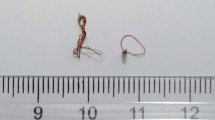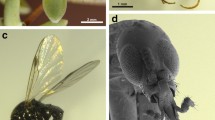Abstract
The major fruit fly attractant component in the floral fragrance of Bulbophyllum cheiri (fruit fly orchid) is methyl eugenol (ME). In the lowland rain forest of Malaysia, the solitary and nonresupinate flowers of the fruit fly orchid attract only males of the ME-sensitive fruit fly species (Bactrocera carambolae, B. papayae, and B. umbrosa. During the morning, the fruit fly orchid flower is visited by many fruit flies, which can sometimes cover the whole flower. The number of visitors dwindles in the afternoon. Headspace analysis of the flower shows a high ME peak in the morning, a small one between 12:00 and 14:00 hr, and no detectable ME peak after 14:00 hr. The process of pollination in the wild is initiated by attraction of fruit flies to floral ME. The flower, with the aid of its specialized hinged see-saw lip (labellum), temporarily traps (<1 min) a fruit fly pollinator between its lip and column. Just prior to this, the fly is rewarded by the opportunity to feed on the floral attractant found on surfaces of petals, sepals, and lip. The pollinaria borne by two wild B. papayae males (caught on and near the fruit fly orchid flower) are identical in morphology and structure with those obtained from the flower. Many of the B. papayae males (17 of 22 analyzed) attracted to the fruit fly orchid already possessed both ME metabolites, trans-coniferyl alcohol and 2-allyl-4,5-dimethoxyphenol, in their rectal glands, indicating that they had previously consumed ME. In this orchid–fruit fly association, both organisms gain direct reproductive benefits: the orchid flower gets pollinated without having to offer nectar, while the fruit fly boosts its pheromone and defense system, as well as its sexual competitiveness by feeding on the ME produced by the flower.
Similar content being viewed by others
REFERENCES
Borba, E. L. and Semir, J. 1998a. Bulbophyllum xcipoense (Orchidaceae), a new natural hybrid from the Brazilian campos rupestres: description and biology. Lindleyana 13:113–120.
Borba, E. L. and Semir, J. 1998b.Wind-assisted fly pollination in three Bulbophyllum (Orchidaceae) species occurring in the Brazilian campos rupestres Lindleyana 13:203–218.
Christensen, D. E. 1994. Fly pollination in the Orchidaceae, pp. 415–454, in J. Arditti (ed.). Orchid Biology: Reviews and Perspectives, VI. John Wiley & Sons, New York.
Kaiser, R. 1993. The Scent of Orchids—Olfactory and Chemical Investigations. Elsevier, Amsterdam, p. 259.
Kevan, P. G. and Baker, H. G. 1983. Insects as flower visitors and pollinators. Annu. Rev. Entomol. 28:407–543.
Metcalf, R. L. and Metcalf, R. E. 1992. Plant Kairomones in Insect Ecology and Control. Chapman and Hall, New York, p. 168.
Nishida, R., Tan, K. H., Serit, M., Lajis, N. H., Sukari, S., Takahashi, S., and Fukami, H. 1988. Accumulation of phenylpropanoids in the rectal glands of males of the oriental fruit fly, Dacus dorsalis. Experientia 44:534–536.
Ridley, H. N. 1890. On the method of fertilization in Bulbophyllum macranthum, and allied orchids. Ann. Bot. 4:327–336.
Symthe, R. 1969. An observation on the pollination of Bulbophyllum baileyi. Orchadian 3:61.
Tan, K. H. 1985. Estimation of native populations of male Dacus spp. by Jolly's stochastic method using a new designed attractant trap in a village ecosystem. J. Plant Prot. Tropics 2:87–95.
Tan, K. H. 2000a. Behaviour and chemical ecology of Bactrocera flies, pp. 647–656. in K. H. Tan (ed.). Area-Wide Control of Fruit Flies and Other Insect Pests. USM Press, Penang.
Tan, K. H. 2000b. Sex pheromone components in the defense of the melon fly, Bactrocera cucurbitae against the Asian House gecko, Hemidactylus frenatus. J. Chem. Ecol. 26:697–704.
Tan, K. H. and Nishida, R. 1996. Sex pheromone and mating competition after methyl eugenol consumption in the Bactrocera dorsalis complex. pp. 147–153. in B. A. McPheron and G. J. Steck (eds.). Fruit Fly Pests—A World Assessment of their Biology and Management. St. Lucie Press, Florida.
Tan, K. H. and Nishida, R. 1998. Ecological significance of male attractant in the defense and mating strategies of the fruit fly Bactrocera papayae. Entomol. Exp. Appl. 89:155–158.
Tan, K. H. and Nishida, R. 2000. Mutual reproductive benefits between a wild orchid, Bulbophyllum patens, and Bactrocera fruit flies via a floral synomone. J. Chem. Ecol. 26:533–546.
Tan, K. H. and Serit, M. 1994. Adult population dynamics of Bactrocera dorsalis (Diptera: Tephritidae) in relation to host phenology and weather in two villages of Penang Island, Malaysia. Environ. Entomol. 23:267–275.
Trembly, R. L. 1992. Trends in the pollination ecology of the Orchidaceae: evolution and systematics. Can. J. Bot. 70:642–650.
Van der Pijl, L., and Dodson, C. H. 1969. Orchid Flowers—Their Pollination and Evolution, University of Miami Press, Miami, Florida, 214 pp.
Vermeulen, J. J. 1991. Orchids of Borneo. Vol. 2—Bulbophyllum. Bentham-Moxon Trust, Toihaan Publishing Co. and The Sabah Society, Kota Kinabalu, Sabah, Malaysia, 342 pp.
Author information
Authors and Affiliations
Rights and permissions
About this article
Cite this article
Tan, KH., Nishida, R. & Toong, YC. Floral Synomone of a Wild Orchid, Bulbophyllum cheiri, Lures Bactrocera Fruit Flies for Pollination. J Chem Ecol 28, 1161–1172 (2002). https://doi.org/10.1023/A:1016277500007
Issue Date:
DOI: https://doi.org/10.1023/A:1016277500007




